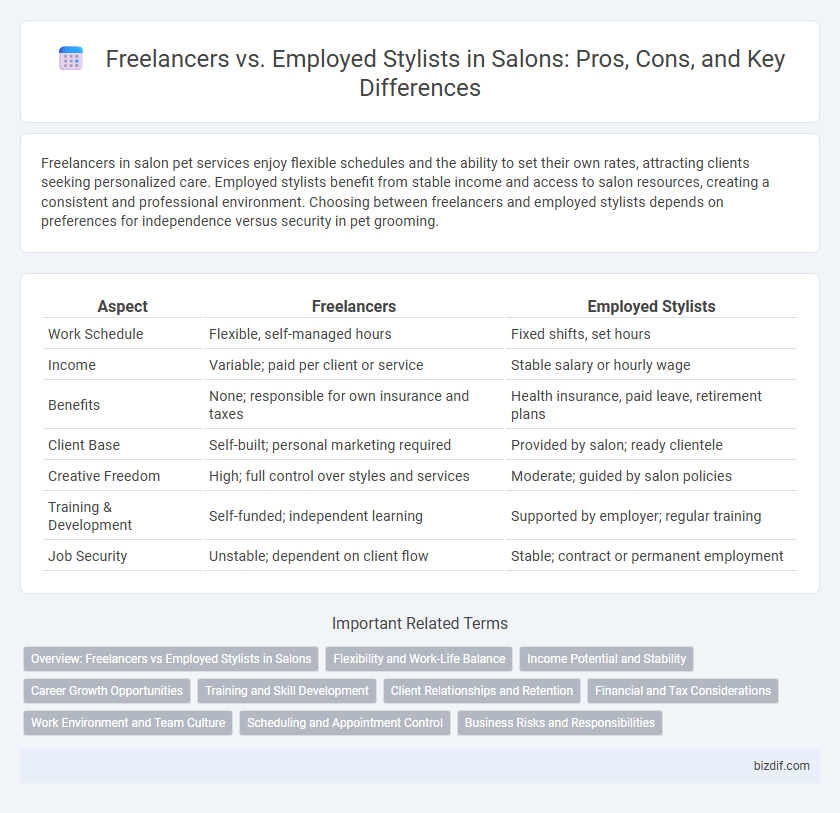Freelancers in salon pet services enjoy flexible schedules and the ability to set their own rates, attracting clients seeking personalized care. Employed stylists benefit from stable income and access to salon resources, creating a consistent and professional environment. Choosing between freelancers and employed stylists depends on preferences for independence versus security in pet grooming.
Table of Comparison
| Aspect | Freelancers | Employed Stylists |
|---|---|---|
| Work Schedule | Flexible, self-managed hours | Fixed shifts, set hours |
| Income | Variable; paid per client or service | Stable salary or hourly wage |
| Benefits | None; responsible for own insurance and taxes | Health insurance, paid leave, retirement plans |
| Client Base | Self-built; personal marketing required | Provided by salon; ready clientele |
| Creative Freedom | High; full control over styles and services | Moderate; guided by salon policies |
| Training & Development | Self-funded; independent learning | Supported by employer; regular training |
| Job Security | Unstable; dependent on client flow | Stable; contract or permanent employment |
Overview: Freelancers vs Employed Stylists in Salons
Freelancer stylists operate independently, managing their own schedules and client base while paying booth rent to salons. Employed stylists receive a stable income with benefits and rely on the salon for clientele and supplies. Salons benefit from employed stylists through consistent branding and control, whereas freelancers offer flexibility but less salon oversight.
Flexibility and Work-Life Balance
Freelance stylists enjoy greater flexibility in scheduling appointments, allowing them to tailor work hours around personal commitments, which enhances work-life balance. Employed stylists often follow fixed shifts, providing more stable income but less control over their time availability. This difference significantly impacts lifestyle choices, with freelancers prioritizing autonomy and employed stylists valuing consistency.
Income Potential and Stability
Freelancer stylists often have higher income potential due to flexible pricing and multiple client sources but face inconsistent earnings and lack of employee benefits. Employed stylists enjoy stable monthly income with added perks like health insurance and paid leave, yet their earning capacity is typically capped by salon policies and fixed hourly rates. Choosing between freelancing and employment hinges on balancing income flexibility against financial security and benefits within the salon industry.
Career Growth Opportunities
Freelance stylists enjoy diverse client exposure and flexible scheduling, which can accelerate skill development and personal brand building. Employed stylists benefit from consistent income, formal training programs, and potential promotions within established salons, fostering structured career advancement. Both paths offer unique growth opportunities dependent on individual career goals and preferred work environments.
Training and Skill Development
Freelancers in salons often pursue specialized training independently, focusing on niche skills to attract diverse clientele, while employed stylists typically benefit from structured, ongoing skill development programs provided by the salon. Employed stylists gain access to mentorship and standardized workshops that ensure consistent service quality and latest trend adoption. Freelancers must proactively invest in certifications and masterclasses to remain competitive, highlighting a key difference in training approaches between the two roles.
Client Relationships and Retention
Freelancer stylists often build personalized client relationships by offering flexible scheduling and diverse service experiences, enhancing retention through tailored communication and customized care. Employed stylists benefit from salon-supported tools, consistent brand messaging, and loyalty programs that foster client trust and repeat visits. Understanding these dynamics helps salons balance independent creativity with structured client retention strategies to maximize customer satisfaction.
Financial and Tax Considerations
Freelance stylists often face variable income streams and must manage self-employment taxes, including quarterly estimated payments for Social Security and Medicare. Employed stylists typically receive a steady paycheck with taxes withheld by the employer, benefiting from employer-covered contributions to unemployment insurance and workers' compensation. Understanding the impact of deductions, such as business expenses for freelancers versus limited deductions for employees, is crucial for maximizing after-tax income in the salon industry.
Work Environment and Team Culture
Freelance stylists in salons often enjoy greater flexibility and autonomy, allowing them to tailor their work environment to personal preferences, whereas employed stylists benefit from a structured setting with consistent support and resources. Employed stylists typically experience a stronger team culture through regular collaboration, training opportunities, and shared goals fostered by salon management. The choice between freelancing and employment influences daily interactions, professional growth, and integration within the salon community.
Scheduling and Appointment Control
Freelance stylists enjoy flexible scheduling by managing their own appointments, often using personal booking platforms, which allows them to optimize availability based on client demand. Employed stylists typically follow fixed salon hours and rely on salon-managed scheduling systems, resulting in less control over appointment times. This difference impacts client flow, with freelancers balancing autonomy and potential downtime, while employed stylists benefit from steady work but limited scheduling flexibility.
Business Risks and Responsibilities
Freelance stylists face variable income and client retention challenges, requiring proactive marketing and scheduling to maintain steady work, while employed stylists benefit from a fixed salary and employer-provided clientele but have less control over their schedules. Business risks for freelancers include lack of access to benefits like health insurance and retirement plans, increased self-employment taxes, and the need to manage their own liability insurance. Employed stylists carry fewer financial risks but must adhere to salon policies and may face limitations in commission structures and creative freedom.
Freelancers vs Employed Stylists Infographic

 bizdif.com
bizdif.com